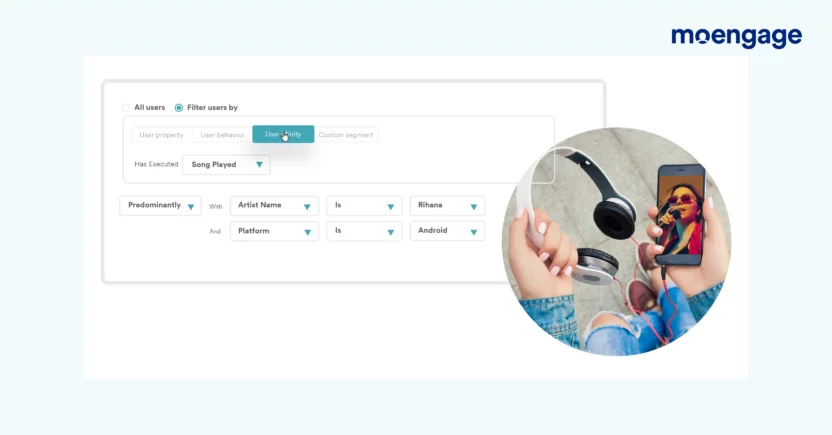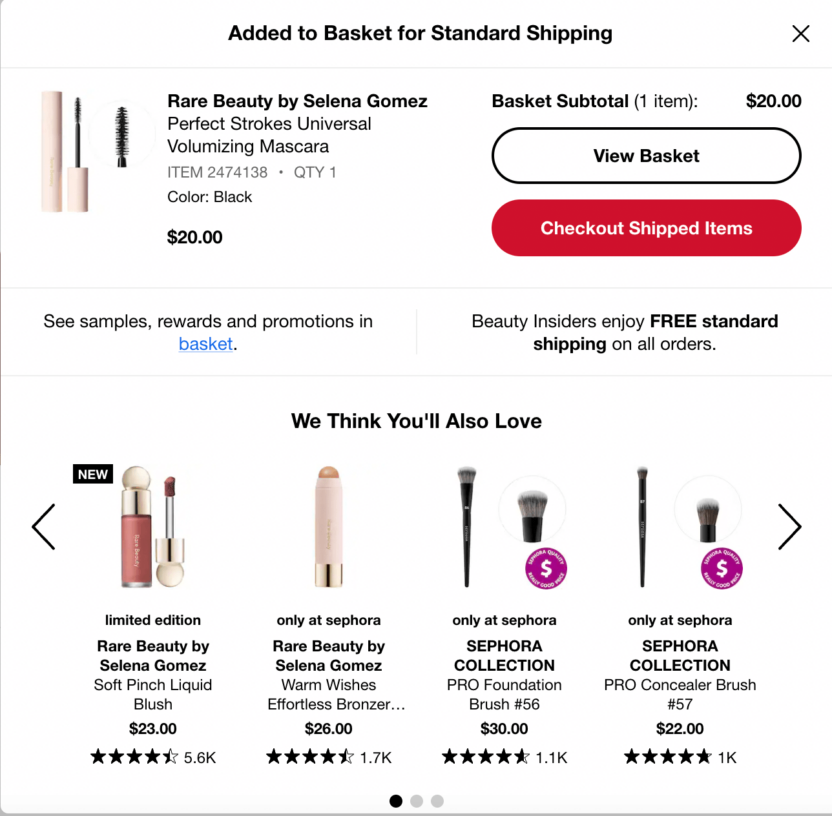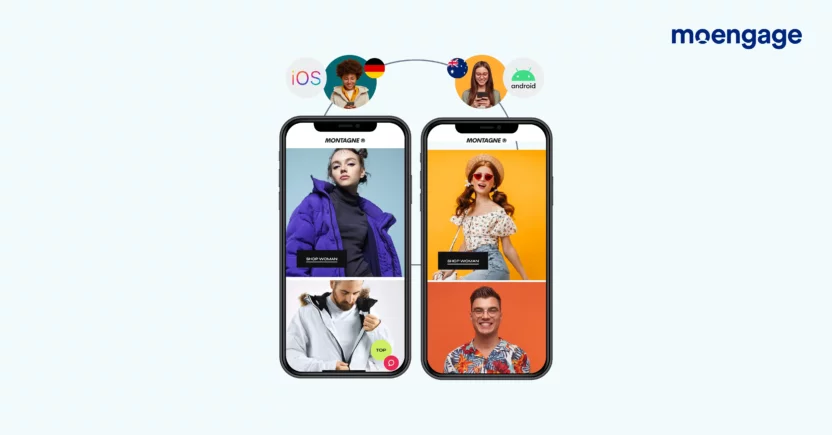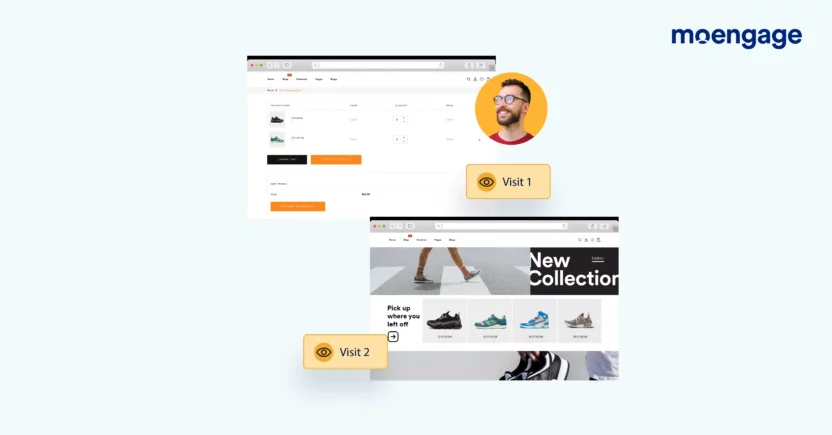Website Personalization For E-commerce Brands: How To Tailor The Online Shopping Experience For Customers

Reading Time: 13 minutes
According to IMARC Group, the worldwide E-commerce market reached 16.6 trillion USD in 2022. The market is set to expand significantly, reaching 70.9 trillion USD by 2028, with an impressive growth rate (CAGR) of 27.43%.
The number of E-commerce stores has grown significantly as well. Estimates say in 2023, there will be 12 million – 24 million E-commerce stores globally. E-commerce retail purchases are expected to increase from 14.1% to 22%.
Increased internet access, demand for convenience, and competitive pricing are some of the most discussed reasons for the growth of the E-commerce industry. The one overlooked aspect often, however, is – Website Personalization.
What Does Website Personalization Mean For Shopping Brands?
Website personalization for shopping brands entails tailoring the website’s content, design, and functionality to the preferences and needs of individual consumers. Analyzing past behavior and data and using machine learning algorithms to provide personalized recommendations, product suggestions, and promotional offers are all elements of website personalization.
For shopping brands, this includes displaying personalized content based on location or browsing history, recommending products based on previous purchases, and using personalization techniques to create a more seamless web experience are just some examples of website personalization.
|
Read more about How Leading Consumer Brands Are Leveraging Website Personalization! |
Website personalization and E-commerce are two trends growing simultaneously and interdependently in the digital age. Think of the relationship between website personalization and E-commerce as that of a chef and a restaurant.
|
Just as a chef creates customized meals based on each customer’s preferences and dietary restrictions, website personalization seeks to create a customized online experience for each customer. The chef selects and prepares ingredients to create a meal tailored to the individual’s tastes. At the same time, E-commerce merchants use data and analytics to tailor their product offerings and marketing messages to each customer’s unique preferences and behaviors. Both the chef and the E-commerce merchant use their knowledge and understanding of their customers to create an experience that is enjoyable, memorable, and uniquely suited to each individual’s needs and desires. |
What Are The Advantages Of Website Personalization For E-Commerce Brands?
Here are the advantages of Web Personalization:
- Boost the revenue by providing personalized content and recommendations to customers, including upsells
- Increase Conversion Rates
- Uplift in Average Order Values
- Significantly reduce Cart Abandonment
- Enhance campaign effectiveness with personalized promotions and discounts that help target consumers who are most likely to buy
Introducing Web Personalization By MoEngage PersonalizeMoEngage Personalize’s powerful website personalization suite is a plug-and-play tool that comes loaded with easy-to-use features without depending on your dev or design teams. |
How Can E-Commerce Brands Use Website Personalization?
Here are a few ways E-Commerce can create personalized web experiences with MoEngage Personalize:
- By utilizing past data and behavior, you can prompt customers and anonymous visitors to perform specific actions, such as filling out a form or scheduling a consultation, resulting in higher conversion rates and, ultimately, more business for your brand
- Tailoring the shopping experience to the context of the customer by customizing the website interaction based on their status as new or returning visitors
- Encourage shoppers to complete their purchases by reminding and urging them to take the next step when they have items in their shopping cart
- Tailor your online browsing experience by taking into account real-time attributes such as geographic location, time of day, the device in question, and other relevant factors
- Encourage shoppers to proceed with their browsing experience by reminding them of previously viewed items and prompting them to continue where they left off
- Customize the online experience according to the customer’s identity, preferences, and interests
- Tailor product suggestions to customers by utilizing their past purchase history, and use MoEngage’s Dynamic Product Messaging and Personalize to recommend relevant upsells or complimentary items
- Retain your valuable customers by enticing them to enroll in the loyalty rewards program and keep them engaged by communicating exclusive offers and loyalty points targeted specifically at this group
- Effortlessly integrate your customer interactions across various channels, including email, advertisements, push notifications, SMS, WhatsApp, and website, to provide a cohesive experience
- Conduct A/B testing on different versions of page layouts, messaging, pricing, and call-to-action (CTA) buttons, and analyze the data and insights gathered to determine which variation performs best
Let’s have a detailed look at the various website personalization use cases based on the stage of the customer journey by leading brands:
Website Personalization Use Cases Based On Customer Journey
New Visitors v/s Returning Visitors
Welcoming new visitors and returning visitors to your E-commerce website requires different approaches.
For new visitors, making a good first impression is essential by providing a clear and simple user interface, easy navigation, and relevant product recommendations. A welcome message or a pop-up offering a discount or a special promotion can also be a great way to engage them.
On the other hand, returning visitors are already familiar with your website, and personalization can help enhance their shopping experience. Your shopping website can provide personalized product recommendations, customized discounts, and exclusive offers by analyzing previous purchases and browsing history.
Moreover, welcoming returning visitors back with a personalized message or a tailored homepage can create a sense of belonging and loyalty towards your brand.
Benefits:
- A more engaging and relevant website experience can increase website visitor’s stickiness
- Personalization tactics like discounts, improved SEO, etc., result in an increased number of website visitors
- Personalized discounts and offers encourage visitors to make a purchase and improve your Average Order Value (AOV)
How To Do It With MoEngage
Journey stage: Customer Acquisition + Onboarding
Goal: To improve web experience amongst first-time and regular shoppers
|
Scenario 1: New visitors visiting the website for the first time. Solution: Personalizing the website banner with top-selling product categories is a great way for E-commerce websites to showcase product range and attract customers’ attention. Showing the top-selling product categories makes first-time visitors more likely to find products that interest them, leading to increased click-through rates and conversions. Here is how Fiverr does it:
Scenario 2: Returning visitors who have browsed through a few website sections. Solution: By offering a personalized discount or promotion on the latest products or categories that customers have browsed, E-commerce websites can encourage them to purchase. Moreover, personalizing the website banner can also help shopping websites build customer loyalty. By offering personalized promotions and discounts, customers feel valued and are more likely to return to the website for future purchases.
Additionally, you can also re-arrange the categories on your home page depending on the customer’s past history.
Learn how FNP Witnesses a 40% Conversion Rate on Cart Abandonment Campaigns With MoEngage here. |
Abandoned Cart Winback
Abandoned Cart Winback refers to sending targeted messages to customers who have added items to their online shopping cart but still need to complete their purchase. The aim is to entice them back to complete the transaction.
Personalized Abandoned Cart Winback messages may include a reminder of the items left in the cart and recommendations for complementary products or related items.
Benefits:
- Reduced cart abandonment by improving the overall customer experience
- Relevant product recommendations and customized messaging based on customer data help improve Conversion Rates
- Increase conversions from the ‘add to cart’ stage by addressing specific barriers that may be preventing customers from completing their purchase
How To Do It With MoEngage
Journey stage: Retention + Conversion
Goal: To increase Conversion Rate amongst first-time and regular shoppers
|
Scenario 1: Customers who have added products to the cart but have concerns about shipping costs, payment method, or want to purchase it later. Solution: Personalization can help address customers’ concerns about shipping costs, payment methods, or the timing of their purchases. Using previous browsing and purchasing history, businesses can tailor their messaging and nudge the customer to complete their purchase. Scenario 2: Customers are waiting to get a good deal or offer or purchase it during a sale. Solution: One way to personalize messaging is to offer exclusive discounts or early access to sales to customers who have shown interest in specific products or categories. You can also personalize the website banner with an offer on products in the cart to nudge a purchase.
|
Web Personalization Based On In-session Attributes
In-session attributes, such as the customer’s location, device type, or browsing behavior, can help tailor web content and functionality to the customer’s preferences and needs. For example, a website can offer personalized recommendations based on the customer’s browsing behavior or adjust the layout and functionality of the site based on the device type.
Benefits:
- By providing relevant and localized content, improving the customer experience, and building trust, MoEngage can ultimately increase visitor stickiness to your website
- Customized product offerings and specific discounts can improve purchase conversion rates
- By tailoring the experience to the individual visitor’s needs, you can create a more satisfying experience resulting in more on-site engagement

How To Do It With MoEngage
Journey stage: Retention and Revenue Growth
Goal: Create context-rich experiences that translate into higher conversion rates
|
Scenario 1: Website visitors across geographies interested in curated products for their location. Solution: Website personalization can help by tailoring the content and experience to the visitors’ needs. This can include using geolocation to show relevant products, highlighting local promotions, and offering content in the visitor’s preferred language. Scenario 2: Running multiple promotional campaigns and the requirement to showcase different discounts based on time of day and visitor device. Solution: By targeting visitors with specific offers based on their behavior, the time of day, and their device, personalization can improve the customer experience. You can also show offers and products based on their device and usage time.
|
Abandoned Browse-Winback
Abandoned Browse-Winback is a strategy used in E-commerce to re-engage potential customers who have browsed products on a website but still need to complete a purchase. The goal is to win back those potential customers. You can do this by sending them personalized and targeted reminders of the products they left in their cart and nudging them to complete their purchase.
Benefits:
- By using personalized offers and promotions based on the customer’s browsing and purchase history, you provide more re-engagement and increased retention of customers
- This strategy allows you to provide an option to activate a nudge from the browser for the customer to ‘add to cart’
- By updating customers about products being back in stock or suggesting similar products based on their browsing history, you can improve conversion rates
How To Do It With MoEngage
Journey stage: Retention + Conversion
Goal: Engage and convert customers who are revisiting your website after an interaction
|
Scenario 1: Users who have visited your site, browsed products or product pages but have yet to purchase. Solution: By reminding website visitors of the products they were interested in and creating a sense of urgency to purchase, personalized offers can help improve conversion rates and recover lost sales. Additionally, using personalized product recommendations and targeted messaging can further increase the consumer’s likelihood of purchasing. Scenario 2: Users are waiting around to get a good deal or purchase it during a sale, or customers may have dropped off due to the unavailability of a product. Solution: Personalize website banners with an offer on products last viewed or update them about products being back in stock to create a sense of urgency and encourage customers to purchase.
|
Segment And Affinity-based Personalized Experiences
Segment and affinity-based personalized experiences are two strategies to provide customers with a more customized and relevant experience. Segment-based personalization involves dividing customers into segments based on common characteristics, while affinity-based personalization involves analyzing customer behavior and interests to create personalized experiences.

Benefits:
- Providing personalized recommendations based on user affinity can help improve conversions
- You can provide relevant content and offers across various customer segments
- A personalized experience for different customer segments will ensure they are more engaged on the website
How To Do It With MoEngage
Journey stage: Retention + Conversion
Goal: To engage customers with the most relevant content through personalization
|
Scenario: Customers have an affinity towards different products and categories and are more likely to purchase based on these affinities and preferences. Solution: By segmenting customers and using affinity-based personalization, you can identify their preferences and interests and create personalized experiences which are more likely to resonate with them. You can add the most relevant products and messaging to your website pages so that it resonates with each audience segment.
|
Product Recommendations Based On Past Purchases
By analyzing a customer’s purchase history and recommending similar products or complementary items they may be interested in purchasing, you can increase their engagement and promote purchases on your website. This is especially helpful for repeat purchases from customers.
Benefits:
- Recommendations that are more likely to be of interest to the customer lead to more purchases
- A positive, personalized experience can lead to increased customer loyalty, repeat purchases, and word-of-mouth referrals
- Growth in average revenue per customer because of more time spent on the website

How To Do It With MoEngage
Journey Stage: Post Purchase + Improve LTV
Goal: To increase Customer Lifetime Value and Loyalty
|
Scenario 1: The customer has already purchased an item, but there is room for more upselling and cross-selling. Solution: MoEngage’s Dynamic Product Messaging (DPM) is designed to help businesses communicate relevant products from their catalog based on the customer’s browsing history through push notifications (app/ web) and emails. It is built upon the platform’s proprietary Sherpa Interaction Graph, which maps each customer’s behavior with the products/ content from the catalog and powers these product recommendations. Scenario 2: Customers don’t see the size/color of their choice, the item is out of stock, or the price is too high. Solution: Personalized website banners with an offer on products last viewed can help customers convert. For example, if a customer is searching for a particular style of shoes that are out of stock, recommendations may suggest similar styles that are currently available or that the customer has purchased in the past. |
Loyalty Program Engagement
Loyalty program engagement refers to the level of participation and activity of customers in a company’s loyalty program. High levels of loyalty program engagement indicate customer loyalty and can result in increased customer lifetime value, higher purchase frequency, and improved customer satisfaction.
Benefits:
- Offering exclusive rewards and promotions to loyalty program members can help increase their lifetime value by incentivizing them to make repeat purchases
- It can help create a sense of stickiness on a website by incentivizing customers to return
- It is one of the few places where you can opt for a reward points redemption campaign
How To Do It With MoEngage
Journey: Post-purchase. Customer retention. Lifetime value (LTV)
Goal: To increase LTV and customer loyalty
|
Scenario 1: Using a loyalty rewards program, your brand wants to improve customer retention. Solution: Use RFM (recency, frequency, monetary) analysis to identify loyal customers and create a personalized experience enticing them to sign-up for the Loyalty program. RFM looks at three factors: how recently customers have made purchases, how frequently they shop, and how much they spend. RFM analysis can help businesses optimize their loyalty program and drive customer engagement. Scenario 2: You have customers that are members of the loyalty program—but you want to nudge them with special offers based on loyalty program tier and points. Solution: By displaying personalized banners, businesses can create a sense of exclusivity for program members and offer them deals and promotions that are not available to non-members. This can help imbibe a sense of brand loyalty and encourage program members to make more purchases. |
Connected Experiences
Connected Experiences in the customer journey of E-commerce companies refer to the seamless and holistic experiences that customers have across all touchpoints with the brand. This includes interactions across various channels, such as website browsing, social media engagement, email communications, in-store experiences (if applicable), and more.
Benefits:
- Connected Experiences can help lift the Average Order Value (AOV) by creating a seamless customer journey across every touchpoint
- By creating a cohesive and integrated customer experience, E-commerce companies can build trust and get more repeat purchases
- Delivering personalized and relevant experiences that meet a customer’s unique needs results in more visits and purchase conversions
How To Do It With MoEngage
Customer Journey: Customer Retention and Revenue Growth
Goal: To improve acquisition and drive retention across customer segments
|
Scenario 1: You have segmented your customers, want to run different offers for each segment, and want to showcase only the relevant offers to each customer segment. Solution: Provide segment-specific discounts, for example: Segment A -> 50% OFF. Segment B -> 20% OFF. Communicate these messages via email / SMS campaigns. Ensure that your website has similar messaging too. Scenario 2: You are running an acquisition campaign via targeted ads and are running multiple offers as part of this campaign. You want to create symmetric messaging across your ads and website. Solution: Personalize website banners using UTM parameters to create symmetric messaging and offers in line with the ads. This means that the banner messaging and offers can be tailored to match the original ad, providing a more consistent and personalized experience for the customer. Learn how you can create connected experiences with MoEngage’s Google Ads Audience Sync. |
Messaging Strategy In Sync With A/B Tests
A/B Testing in E-commerce Personalization refers to the practice of testing different versions of personalized messages. This is to determine which version performs better in terms of achieving specific goals.
Benefits:
- Testing different variations of personalized messages can help you analyze which one leads to a higher average order value
- Improved communication leads to an increased number of visitors and conversions
- Personalized recommendations, exclusive offers, and targeted promotions can improve the stickiness of your website
How To Do It With MoEngage
Journey stage: Acquisition, Retention, and LTV
Goal: To experiment and arrive at the best-performing variant that improves conversions
|
Scenario 1: Your brand is launching a new product category, and you want to test out which messaging strategy works best. Solution: Launch new products with A/B test and preview experiences. By creating two or more versions of the website or marketing materials, each with a different messaging strategy, you can test which messaging resonates best with your audience and the efficacy of your efforts against key metrics. Scenario 2: You are running a new festive campaign and want to test which messaging resonates with customers the most. Solution: Have pre-defined goals and experiment with different web page versions. The version that performs better can then be selected and used for the rest of the campaign.
|
Conclusion
The E-commerce industry has seen hockey-stick growth in recent years and continues to grow at an impressive rate. In today’s market, where there is cut-throat competition and numerous options for consumers to choose from, it is essential to differentiate yourself from others. Website Personalization allows your brand to provide customized, meaningful, and timely interactions that connect with your target audience and customers.
MoEngage’s website personalization provides customized online experiences to E-commerce customers, leading to higher engagement, conversion rates, and customer loyalty. MoEngage offers various website personalization use cases, including welcoming new visitors, encouraging abandoned cart win-back, and personalizing product recommendations based on a customer’s purchase history.
MoEngage’s website personalization empowers E-commerce brands to create a personalized and relevant browsing and shopping experience, ultimately leading to higher revenue for the brand.
MoEngage helps you achieve all this at speed and scale without a single line of code.
Excited to learn how your brand can implement Web Personalization?
If you’re an existing customer, contact your favorite customer success manager or talk to our experts here.
Bonus Reads
- What Is Conversational Commerce and How Can It Help Your Business?
- Website Personalization Examples: How Are Leading Brands Doing It?
- Personalization: Missing Ingredient of a Great Customer Experience Strategy
- MoEngage Flows: Create Personalized Experiences With An Enterprise-Ready Automated Customer Journey Builder
- [Customer Spotlight] How GIVA Recorded 120% Uplift in Conversions Using MoEngage’s Newly Launched Smart Recommendations!















